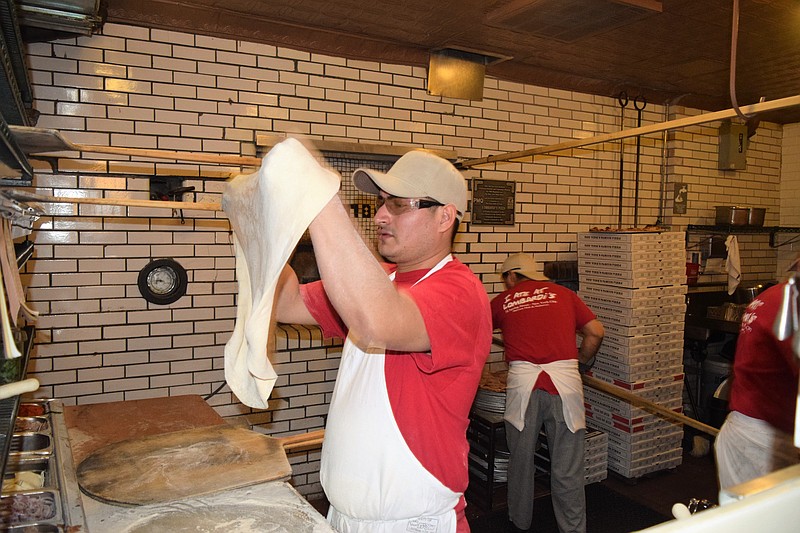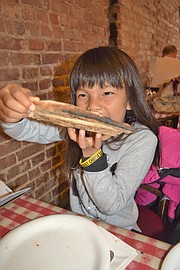NEW YORK - It's a brisk spring morning as a group of strangers gathers on the streets of New York. Our backgrounds are as diverse as the city's population. Among them: retirees from Portugal, a flight attendant from Kansas City, the chief financial officer of a synagogue in San Francisco, a family from Los Angeles, a couple from Sacramento, Calif.
But there's one thing we all have in common: a love of pizza and a desire to learn more about it and the people who make them in an area of the city where it all began, Little Italy and Soho.
New York City food tours
There are numerous tours to be taken. Here are several favorites.› Best of Brooklyn: This half-day tour takes you by bus through Brooklyn to taste and learn about the evolution of the borough’s culinary culture. Starts at $125. www.foodsny.com.› Culinary Farm Tour and Tasting: Experience rare herbs, edible flowers and more inside an indoor farm in the heart of Manhattan. $50. https://farm.one.>› Flatiron Food, Architecture and History Tour: Spend two and a half hours in two of New York’s most iconic neighborhoods and enjoy six full tastings at local eateries. Starts at $50. www.likealocaltours.com.› Chinatown Food Tour: The half-day tour will take you through this famous neighborhood for shopping and eating along the way. $99. manhattanwalkingtour.com.› Scott’s Pizza Tours: Walk through Soho and Little Italy (daily) or board a bus (Sundays only) and visit four boroughs to learn about the history of pizza from Europe to the streets of New York. Private tours also available. Starts at $40. www.scottspizzatours.com.
New York pizza crust
Scott’s Pizza Tours provides this dough recipe for an authentic New York City pizza crust. Pizza Dough 455 grams water (roughly 1.9 cups) 700 grams flour (roughly 4.9 cups) 3.5 grams dry yeast (1 teaspoon) 14 grams salt (2 1/2 teaspoons) Mix together all ingredients; cover and let rest for 30 minutes in draft-free area. Knead until springy and smooth. Split into four balls of equal size and place in lightly oiled container. Place in refrigerator overnight. When ready, stretch each dough ball onto pizza pan, top with sauce and toppings, place on pizza stone and bake at 450 degrees until crust is golden brown. Note: For a faster rise, use warm water and a pinch of sugar. Do not refrigerate.
Scott's Pizza Tours is one of several tour businesses started by entrepreneurs wanting to share their love of pizza. Being the oldest, it seemed like the best choice, offering a choice of walking tours or tours by bus to farther reaches of the city. I chose the former, as it seemed a good way to walk off all the pizza I would be consuming in the next couple of hours. Plus, it's a nice way to see a part of New York I'd never experienced.
We huddle together against brisk northern winds, but right on time, class begins. The first thing we learn is that we are standing in front of the very first pizzeria in the country. Words of surprise come from all around - who knew?
Gatsby's is emblazoned across the front. But we learn the restaurant was originally home to Lombardi's, opened in 1905 by Gennaro Lombardi, an immigrant from Naples, Italy, where it all began with a simple pie of pita bread topped with little more than tomatoes and cheese. There are looks of disappointment as we hear of its closing, but those are soon replaced with smiles as we learn it simply moved down the street.
So we begin a short walk to the corner of Spring and Mott streets, where a "new" Lombardi's, circa 1994, is already bustling with business, and it's not yet noon.
We walk through the kitchen, where workers are stretching and tossing dough; pizzaiolos are using long paddles, placing pizzas deep inside a brick, coal-fired oven more than 100 years old. We take our seats inside a room lined with tables and learn more about this culinary phenomenon and get a bite of what makes New York a haven for pizza lovers.
"People expect to eat pizza in our tours but do not expect to examine and learn about it at a true pizza guru level," says our guide, Miriam Weiskind, an Ohio native who's been a guide with Scott's Pizza Tours going on five years. "A combination of city and pizza history makes for an adventure in New York City."
"Pizza is such a huge part of the culture of New York City," agrees Kansas City's Beth Johnson, now on her third pizza tour.
Weiskind says the biggest compliment she can get is when pizza lovers return for another tour.
"They're hungry for more pizza knowledge," she says, adding that she recommends taking both the Crosstown Original Tour, the one we are on as we walk the streets of New York, as well as a bus tour that takes people on half-day trips to visit pizzerias from Brooklyn to Queens, the Bronx and Staten Island.
Sharon and Rick Russo, who live in the Sacramento area, are fresh off a tour of taco stands in Mexico, Sharon tells us as she prepares to sample her next slice.
"We enjoy learning about the foods of different regions," she says. "These kind of tours give you a chance to get a history of the city as well as reasons for food development. It's a fun, tasty way to get a history lesson."
And Weiskind adds, "It's all about educating your pizza palate."
Christopher Heywood, senior vice president of global communications for NYC & Co., the city's official tourism marketing organization, says food tours are quickly developing into one of the most-sought-after experiences when visiting the Big Apple, as culinary tourism is one of the hottest trends in travel today.
"They are a great way to discover neighborhoods and culture across all five boroughs," he says. "Visitors enjoy getting the perspective of a local while eating both new and classic New York City food staples, such as pizza."
From Lombardi's, the tour progresses to two more pizzerias, and though the toppings are kept at a bare minimum to teach us the basics of pizza - crust, tomato sauce, cheese and a few spices - the pies are surprisingly different from one pizzeria to the next. This, we learn, is due in part to the type of oven used in baking: traditional coal-fired oven vs. a modern gas oven, the former resulting in a darker, crispier crust.
"I enjoy being a pizza guru here to teach people who like pizza how to love it, by teaching them why and how to love pizza in ways they never imagined," Weiskind says as her class huddles in a park across from Joe's on Carmine, where pizza is sold by the super-size slice made in a gas-fired oven. The crust is lighter in color, a little less crispy than at Lombardi's.
The tour wraps up a couple of blocks down at John's on Bleeker, and we return to crispy pies made in a coal-fired oven - the same one used when John Sasso opened his restaurant in 1929.
"I love these tours," says Andy Plotnick, who brought his wife, Chris, and 7-year-old daughter, Kalea, from their home in Los Angeles to learn about the history of pizza from its roots in Europe across the Atlantic to America. "It's all about the street-culture stuff."
"There is so much variety in New York City that we have endless possibilities of places to tour," Weiskind says. "What people can't get anywhere else, though, is a taste of the very first style of pizza coming from our 100-plus-year-old ovens like those at Lombardi's and John's on Bleeker.
"Of course other cities offer a different history rich in other ways," she says, "but none are quite like New York City."
Contact Anne Braly at abraly@timesfreepress.com.

